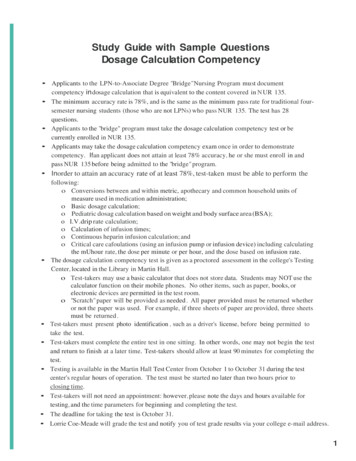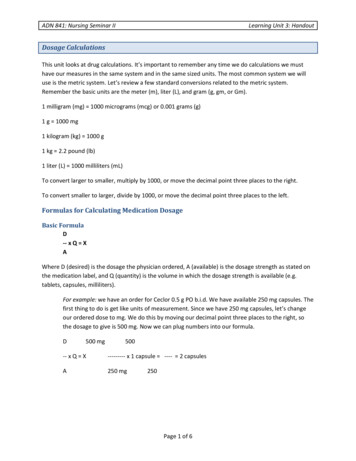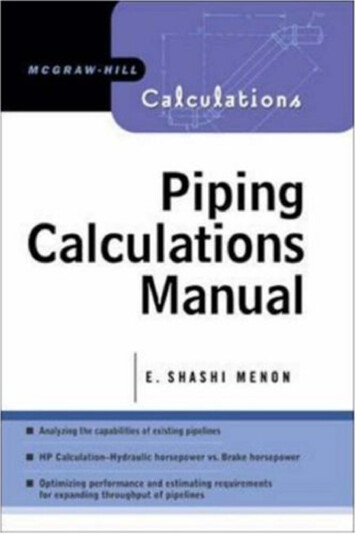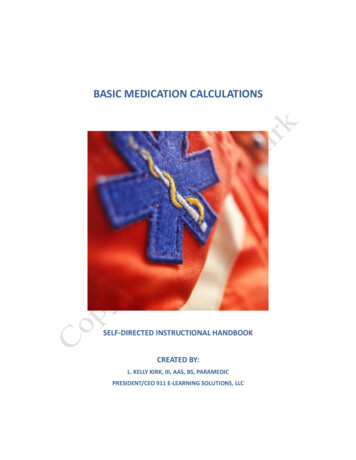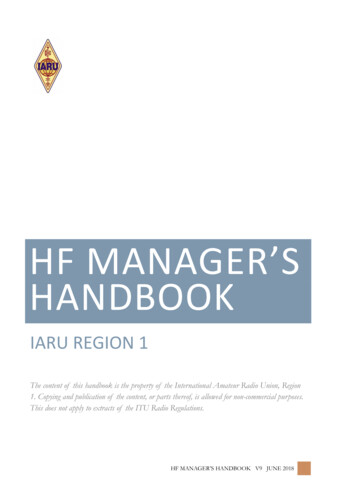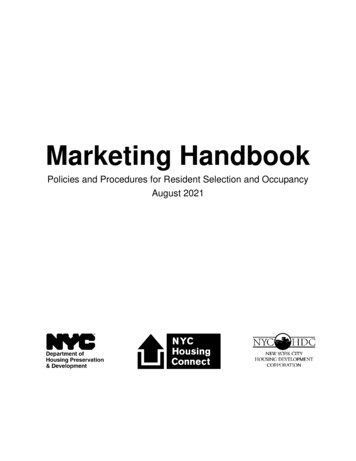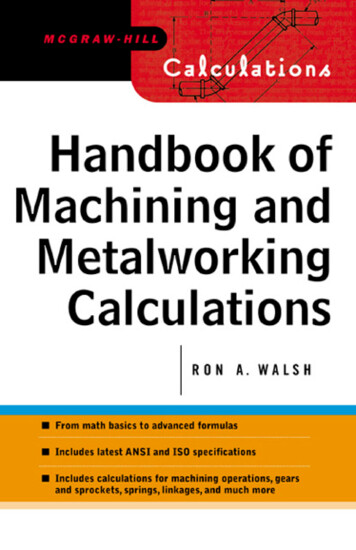
Transcription
HANDBOOK OFMACHININGANDMETALWORKINGCALCULATIONS
This page intentionally left blank.
HANDBOOK OFMACHININGANDMETALWORKINGCALCULATIONSRonald A. WalshMcGRAW-HILLNew York San Francisco Washington, D.C. Auckland BogotáCaracas Lisbon London Madrid Mexico City MilanMontreal New Delhi San Juan SingaporeSydney Tokyo Toronto
Copyright 2001 by The McGraw-Hill Companies, Inc. All rights reserved. Manufactured in the United States ofAmerica. Except as permitted under the United States Copyright Act of 1976, no part of this publication may be reproduced or distributed in any form or by any means, or stored in a database or retrieval system, without the prior written permission of the publisher.0-07-141485-1The material in this eBook also appears in the print version of this title: 0-07-136066-2.All trademarks are trademarks of their respective owners. Rather than put a trademark symbol after every occurrence of a trademarked name, we use names in an editorial fashion only, and to the benefit of the trademark owner,with no intention of infringement of the trademark. Where such designations appear in this book, they have beenprinted with initial caps.McGraw-Hill eBooks are available at special quantity discounts to use as premiums and sales promotions, or foruse in corporate training programs. For more information, please contact George Hoare, Special Sales, atgeorge hoare@mcgraw-hill.com or (212) 904-4069.TERMS OF USEThis is a copyrighted work and The McGraw-Hill Companies, Inc. (“McGraw-Hill”) and its licensors reserve allrights in and to the work. Use of this work is subject to these terms. Except as permitted under the Copyright Actof 1976 and the right to store and retrieve one copy of the work, you may not decompile, disassemble, reverse engineer, reproduce, modify, create derivative works based upon, transmit, distribute, disseminate, sell, publish or sublicense the work or any part of it without McGraw-Hill’s prior consent. You may use the work for your own noncommercial and personal use; any other use of the work is strictly prohibited. Your right to use the work may beterminated if you fail to comply with these terms.THE WORK IS PROVIDED “AS IS”. McGRAW-HILL AND ITS LICENSORS MAKE NO GUARANTEES ORWARRANTIES AS TO THE ACCURACY, ADEQUACY OR COMPLETENESS OF OR RESULTS TO BEOBTAINED FROM USING THE WORK, INCLUDING ANY INFORMATION THAT CAN BE ACCESSEDTHROUGH THE WORK VIA HYPERLINK OR OTHERWISE, AND EXPRESSLY DISCLAIM ANY WARRANTY, EXPRESS OR IMPLIED, INCLUDING BUT NOT LIMITED TO IMPLIED WARRANTIES OF MERCHANTABILITY OR FITNESS FOR A PARTICULAR PURPOSE. McGraw-Hill and its licensors do not warrantor guarantee that the functions contained in the work will meet your requirements or that its operation will be uninterrupted or error free. Neither McGraw-Hill nor its licensors shall be liable to you or anyone else for any inaccuracy, error or omission, regardless of cause, in the work or for any damages resulting therefrom. McGraw-Hill hasno responsibility for the content of any information accessed through the work. Under no circumstances shallMcGraw-Hill and/or its licensors be liable for any indirect, incidental, special, punitive, consequential or similardamages that result from the use of or inability to use the work, even if any of them has been advised of the possibility of such damages. This limitation of liability shall apply to any claim or cause whatsoever whether such claimor cause arises in contract, tort or otherwise.DOI: 10.1036/0071414851
Want to learn more?We hope you enjoy this McGraw-Hill eBook!If you d like more information about thisbook, its author, or related books and websites,please click here.
For more informa tion a bout this book, click he re .CONTENTSPrefaceixChapter 1. Mathematics for Machinists and Metalworkers1.11.1 Geometric Principles—Plane Geometry / 1.11.2 Basic Algebra / 1.71.2.1 Algebraic Procedures / 1.71.2.2 Transposing Equations (Simple and Complex) / 1.91.3 Plane Trigonometry / 1.111.3.1 Trigonometric Laws / 1.131.3.2 Sample Problems Using Trigonometry / 1.211.4 Modern Pocket Calculator Procedures / 1.281.4.1 Types of Calculators / 1.281.4.2 Modern Calculator Techniques / 1.291.4.3 Pocket Calculator Bracketing Procedures / 1.311.5 Angle Conversions—Degrees and Radians / 1.321.6 Powers-of-Ten Notation / 1.341.7 Percentage Calculations / 1.351.8 Temperature Systems and Conversions / 1.361.9 Decimal Equivalents and Millimeters / 1.371.10 Small Weight Equivalents: U.S. Customary (Grains and Ounces) Versus Metric(Grams) / 1.381.11 Mathematical Signs and Symbols / 1.39Chapter 2. Mensuration of Plane and Solid Figures2.12.1 Mensuration / 2.12.2 Properties of the Circle / 2.10Chapter 3. Layout Procedures for Geometric Figures3.13.1 Geometric Constructions / 3.1Chapter 4. Measurement and Calculation Procedures for Machinists4.14.1 Sine Bar and Sine Plate Calculations / 4.14.2 Solutions to Problems in Machining and Metalworking / 4.64.3 Calculations for Specific Machining Problems (Tool Advance, Tapers, Notches andPlugs, Diameters, Radii, and Dovetails) / 4.154.4 Finding Complex Angles for Machined Surfaces / 4.54vCopyright 2001 by The McGraw-Hill Companies, Inc. Click Here for Terms of Use.
viCONTENTSChapter 5. Formulas and Calculations for Machining Operations5.15.25.35.45.55.65.75.8Turning Operations / 5.1Threading and Thread Systems / 5.12Milling / 5.22Drilling and Spade Drilling / 5.38Reaming / 5.61Broaching / 5.63Vertical Boring and Jig Boring / 5.66Bolt Circles (BCs) and Hole Coordinate Calculations / 5.67Chapter 6. Formulas for Sheet Metal Layout and Fabrication6.16.26.36.46.55.16.1Sheet Metal Flat-Pattern Development and Bending / 6.8Sheet Metal Developments, Transitions, and Angled Corner Flange Notching / 6.14Punching and Blanking Pressures and Loads / 6.32Shear Strengths of Various Materials / 6.32Tooling Requirements for Sheet Metal Parts—Limitations / 6.36Chapter 7. Gear and Sprocket Calculations7.17.1 Involute Function Calculations / 7.17.2 Gearing Formulas—Spur, Helical, Miter/Bevel, and Worm Gears / 7.47.3 Sprockets—Geometry and Dimensioning / 7.15Chapter 8. Ratchets and Cam Geometry8.18.1 Ratchets and Ratchet Gearing / 8.18.2 Methods for Laying Out Ratchet Gear Systems / 8.38.2.1 External-Tooth Ratchet Wheels / 8.38.2.2 Internal-Tooth Ratchet Wheels / 8.48.2.3 Calculating the Pitch and Face of Ratchet-Wheel Teeth / 8.58.3 Cam Layout and Calculations / 8.6Chapter 9. Bolts, Screws, and Thread Calculations9.19.1 Pullout Calculations and Bolt Clamp Loads / 9.19.2 Measuring and Calculating Pitch Diameters of Threads / 9.59.3 Thread Data (UN and Metric) and Torque Requirements (Grades 2, 5, and 8 U.S.Standard 60 V) / 9.13Chapter 10. Spring Calculations—Die and Standard Types10.1 Helical Compression Spring Calculations / 10.510.1.1 Round Wire / 10.510.1.2 Square Wire / 10.610.1.3 Rectangular Wire / 10.610.1.4 Solid Height of Compression Springs / 10.610.2 Helical Extension Springs (Close Wound) / 10.810.1
viiCONTENTS10.3 Spring Energy Content of Compression and Extension Springs / 10.810.4 Torsion Springs / 10.1110.4.1 Round Wire / 10.1110.4.2 Square Wire / 10.1210.4.3 Rectangular Wire / 10.1310.4.4 Symbols, Diameter Reduction, and Energy Content / 10.1310.5 Flat Springs / 10.1410.6 Spring Materials and Properties / 10.1610.7 Elastomer Springs / 10.2210.8 Bending and Torsional Stresses in Ends of Extension Springs / 10.2310.9 Specifying Springs, Spring Drawings, and Typical Problems and Solutions / 10.24Chapter 11. Mechanisms, Linkage Geometry, and Calculations11.111.211.311.411.511.1Mathematics of the External Geneva Mechanism / 11.1Mathematics of the Internal Geneva Mechanism / 11.3Standard Mechanisms / 11.5Clamping Mechanisms and Calculation Procedures / 11.9Linkages—Simple and Complex / 11.17Chapter 12. Classes of Fit for Machined Parts—Calculations12.112.1 Calculating Basic Fit Classes (Practical Method) / 12.112.2 U.S. Customary and Metric (ISO) Fit Classes and Calculations / 12.512.3 Calculating Pressures, Stresses, and Forces Due to Interference Fits, Force Fits, andShrink Fits / 12.9IndexI.1
This page intentionally left blank.
PREFACEThis handbook contains most of the basic and advanced calculation proceduresrequired for machining and metalworking applications. These calculation procedures should be performed on a modern pocket calculator in order to save time andreduce or eliminate errors while improving accuracy. Correct bracketing proceduresare required when entering equations into the pocket calculator, and it is for thisreason that I recommend the selection of a calculator that shows all entered data onthe calculator display and that can be scrolled. That type of calculator will allow youto scroll or review the entered equation and check for proper bracketing sequences,prior to pressing “ENTER” or . If the bracketing sequences of an entered equationare incorrect, the calculator will indicate “Syntax error,” or give an incorrect solutionto the problem. Examples of proper bracketing for entering equations in the pocketcalculator are shown in Chap. 1 and in Chap. 11, where the complex four-bar linkageis analyzed and explained.This book is written in a user-friendly format, so that the mathematical equationsand examples shown for solutions to machining and metalworking problems are notonly highly useful and relatively easy to use, but are also practical and efficient. Thisbook covers metalworking mathematics problems, from the simple to the highlycomplex, in a manner that should be valuable to all readers.It should be understood that these mathematical procedures are applicable for: Master machinistsMachinistsTool designers and toolmakersMetalworkers in various fieldsMechanical designersTool engineering personnelCNC machining programmersThe gunsmithing tradeStudents in technical teaching facilitiesR.A. WalshixCopyright 2001 by The McGraw-Hill Companies, Inc. Click Here for Terms of Use.
This page intentionally left blank.
HANDBOOK OFMACHININGANDMETALWORKINGCALCULATIONS
This page intentionally left blank.
CHAPTER 1MATHEMATICSFOR MACHINISTSAND METALWORKERSThis chapter covers all the basic and special mathematical procedures of value to themodern machinist and metalworker. Geometry and plane trigonometry are of primeimportance, as are the basic algebraic manipulations. Solutions to many basic andcomplex machining and metalworking operations would be difficult or impossiblewithout the use of these branches of mathematics. In this chapter and other subsections of the handbook, all the basic and important aspects of these branches of mathematics will be covered in detail. Examples of typical machining and metalworkingproblems and their solutions are presented throughout this handbook.1.1 GEOMETRIC PRINCIPLES—PLANE GEOMETRYIn any triangle, angle A angle B angle C 180 , and angle A 180 (angle A angle B), and so on (see Fig. 1.1). If three sides of one triangle are proportional to thecorresponding sides of another triangle, the triangles are similar.Also, if a:b:c a′:b′:c′,then angle A angle A′, angle B angle B′, angle C angle C′, and a/a′ b/b′ c/c′.Conversely, if the angles of one triangle are equal to the respective angles of anothertriangle, the triangles are similar and their sides proportional; thus if angle A angleA′, angle B angle B′, and angle C angle C′, then a:b:c a′:b′:c′ and a/a′ b/b′ c/c′(see Fig. 1.2).FIGURE 1.1Triangle.1.1Copyright 2001 by The McGraw-Hill Companies, Inc. Click Here for Terms of Use.
1.2CHAPTER ONEFIGURE 1.2Similar triangles.Isosceles triangle (see Fig. 1.3). If side c side b, then angle C angle B.Equilateral triangle (see Fig. 1.4). If side a side b side c, angles A, B, and Care equal (60 ).Right triangle (see Fig. 1.5). c2 a2 b2 and c (a2 b2)1/2 when angle C 90 .Therefore, a (c2 b2)1/2 and b (c2 a2)1/2. This relationship in all right-angle triangles iscalled the Pythagorean theorem.Exterior angle of a triangle (see Fig. 1.6). Angle C angle A angle B.FIGUREtriangle.1.3FIGURE 1.5IsoscelesRight-angled triangle.FIGURE 1.4Equilateral triangle.FIGURE 1.6Exterior angle of a triangle.
MATHEMATICS FOR MACHINISTS AND METALWORKERS1.3Intersecting straight lines (see Fig. 1.7). Angle A angle A′, and angle B angle B′.FIGURE 1.7Intersecting straight lines.Two parallel lines intersected by a straight line (see Fig. 1.8). Alternate interiorand exterior angles are equal: angle A angle A′; angle B angle B′.Any four-sided geometric figure (see Fig. 1.9). The sum of all interior angles 360 ; angle A angle B angle C angle D 360 .A line tangent to a point on a circle is at 90 , or normal, to a radial line drawn to thetangent point (see Fig. 1.10).FIGURE 1.8FIGURE 1.9figure).Straight line intersecting two parallel lines.Quadrilateral (four-sidedFIGURE 1.10Tangent at a point on a circle.
1.4CHAPTER ONETwo circles’ common point of tangency is intersected by a line drawn between theircenters (see Fig. 1.11).Side a a′; angle A angle A′ (see Fig. 1.12).Angle A 1 2 angle B (see Fig. 1.13).FIGURE 1.11FIGURE 1.12FIGURE 1.13Common point of tangency.Tangents and angles.Half-angle (A).
MATHEMATICS FOR MACHINISTS AND METALWORKERS1.5Angle A angle B angle C. All perimeter angles of a chord are equal (seeFig. 1.14).Angle B 1 2 angle A (see Fig. 1.15).a2 bc (see Fig. 1.16).All perimeter angles in a circle, drawn from the diameter, are 90 (see Fig. 1.17).Arc lengths are proportional to internal angles (see Fig. 1.18). Angle A:angleB a:b. Thus, if angle A 89 , angle B 30 , and arc a 2.15 units of length,arc b would be calculated asFIGURE 1.14Perimeter angles of a chord.FIGURE 1.16FIGURE 1.15Line and circle relationship (a2 bc).Half-angle (B).
1.6CHAPTER ONEFIGURE 1.1790 perimeter angles.FIGURE 1.18Proportional arcs and angles.Angle A aᎏ ᎏAngle B b89 2.15ᎏ ᎏ30b89b 30 2.1564.5b ᎏ89b 0.7247 units of
book, its author, or related books and websites, please click here. CONTENTS Preface ix Chapter 1.Mathematics for Machinists and Metalworkers 1.1 1.1 Geometric Principles—Plane Geometry / 1.1 1.2 Basic Algebra / 1.7 1.2.1Algebraic Procedures / 1.7 1.2.2Transposing Equations (Simple and Complex) / 1.9 1.3 Plane Trigonometry / 1.11 1.3.1Trigonometric Laws / 1.13 1.3.2Sample Problems Using .

